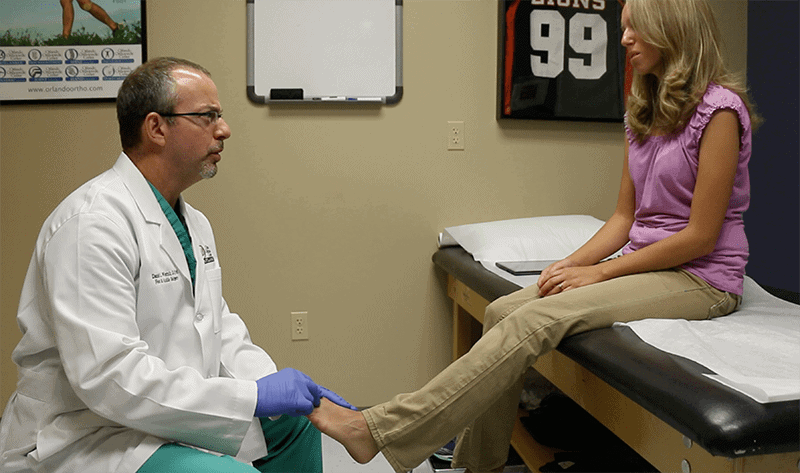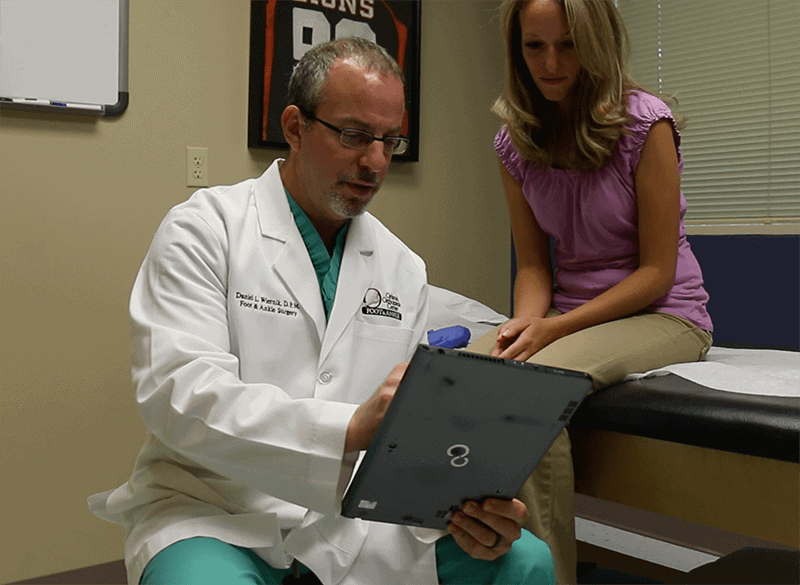Bunionectomy Revision Surgery Helps Mom Get Back on Her Feet
Sixteen years ago, Sherry went through her first bunionectomy surgery on both of her feet. She hoped the procedures would help her walk without pain and be able to wear normal shoes without compromise. She never thought she would need bunionectomy revision surgery years after her original procedures.
Unfortunately, the procedures with the original surgeon didn’t go as planned, and she wound up living in constant pain for almost two decades until she met Daniel L. Wiernik, D.P.M., a board certified foot surgeon at Orlando Orthopaedic Center.
She worked with multiple foot specialists before meeting Dr. Wiernik, and many said there was nothing they could do to repair the original surgeon’s work.
“Numerous doctors told me ‘no’ and that it couldn’t be done and that there was no hope for recovery from the surgeries,” she explains. Through a friend, she decided to try one more specialist.
After meeting with Dr. Wiernik and working together on her treatment plan, she knew bunionectomy revision surgery with him was the right call on her quest for relief.
“He was amazing,” she says with a smile “He was really calm, wasn’t pushy towards me and explained the other options I had besides surgery.”
What is a Bunion?
 A bunion is a bony bump forming at the base of the big toe, creating a union with the first metatarsal resulting in a foot deformity involving both bone and soft tissue. Bunions can be extremely painful and limit one’s ability to walk, run or wear certain types of shoes with narrow toe boxes.
A bunion is a bony bump forming at the base of the big toe, creating a union with the first metatarsal resulting in a foot deformity involving both bone and soft tissue. Bunions can be extremely painful and limit one’s ability to walk, run or wear certain types of shoes with narrow toe boxes.
“I couldn’t keep up with my kids and I was exhausted on a regular basis by 3 p.m.,” Sherry explains.
Wearing shoes that are either too small or too narrow in the toe area are the most common reasons bunions form. However, they can also occur naturally. In general, women are more likely than men to develop bunions, and some research suggests the predisposition for bunions is an inheritable trait. Almost 25% of people between the ages of 18 to 65 and 36% of people older than 65 have bunions or another painful deformity of the big toe.
What is a Bunionectomy?
A bunionectomy involves removing part of the metatarsal head, which is the part of the foot that is bulging out, via an incision in the top or side of the big toe joint. This process can relieve pain and restore normal alignment of the joint. Screws, plates or small wires can be used to hold the bones in place.
It is typically a last resort when conservative treatment options for bunions are exhausted.
Some of the most common conservative treatment methods for bunions may include:
- Using over-the-counter arch supports or prescription orthotic devices to help position the foot correctly
- Maintaining a healthy weight
- Taking nonsteroidal anti-inflammatory drugs like ibuprofen to reduce pain and swelling
- Buying well-fitting shoes with wider tops
- Using warm soaks, ice packs, ultrasound or massage
- Using a moleskin or gel-filled pad to protect the bunion
 For Sherry, she tried all of the options, but the bunionectomy revision surgery was the only option left available to provide relief. In a revision surgery, the surgeon will correct previous errors or make required adjustments to help the patient achieve the best outcomes possible.
For Sherry, she tried all of the options, but the bunionectomy revision surgery was the only option left available to provide relief. In a revision surgery, the surgeon will correct previous errors or make required adjustments to help the patient achieve the best outcomes possible.
“Running wasn’t an option anymore at all,” she says. “I realized the amount of pain I was experiencing wasn’t normal…I decided I needed to look into my options instead of just living with it.”
After meeting Dr. Wiernik, she was ready to commit to the revision surgery to help her move past the failed procedures of another foot specialist.
“He explained what he felt he could do with surgery and let me decide. He was fantastic and really helped ease me into a comfort zone,” she remembers about her initial appointments with Dr. Wiernik.
What Are the Expectations After a Bunionectomy?
“Sherry’s case was very challenging one. She had had surgery about 16 years before she came to see me, and those were unsuccessful,” Dr. Wiernik explains. “She’s had pain all this time, and she had hardware in her feet from prior procedures, so from a surgical standpoint it was complicated.”
Patients, like Sherry, who need bunions removed from both feet should expect to have one surgery at a time.
The typical recovery period following the surgery ranges from six weeks to six months, although it may take up to one year for complete healing. Patients should expect their foot to remain swollen for several months after the procedure.
“Sherry’s right foot is pain-free, and her left foot is doing great,” Dr. Wiernik says. “She just went to Walt Disney World with her family and had no issue keeping up with her kids. Her surgery was very successful.”
She says she has more energy than ever and feels great following her bunionectomy revision surgery.
“It was the best decision I’ve made because I have the energy to keep up with my kids and I can get back to the things I love like singing, running and playing with my dogs,” she says.


